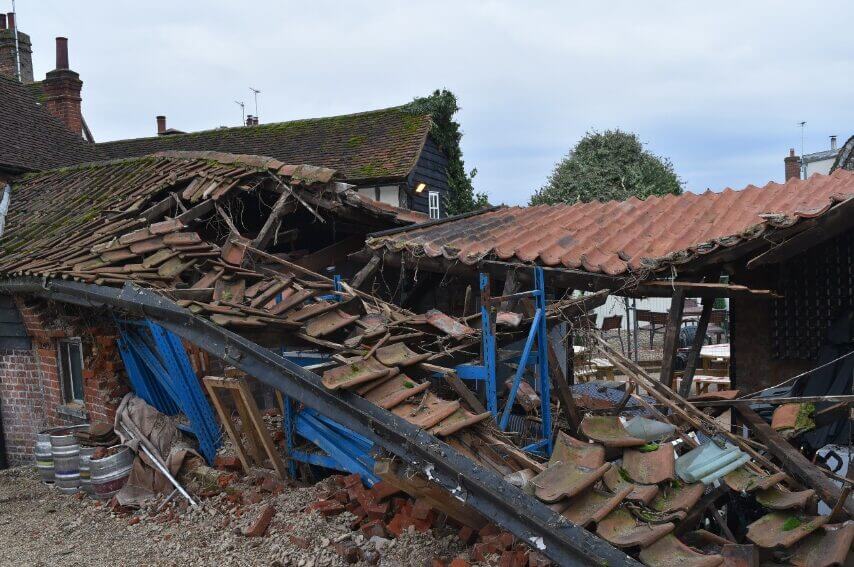Storms can wreak havoc on structures, with winds causing a building (or parts of it) to sway, overturn, or even collapse. Most people expect that buildings should be designed and built to withstand foreseeable storms and so, when Hawkins investigates a storm damaged structure, we must consider what caused the failure: the storm itself, or something else such as the underlying construction or a design defect.
With apologies to Bob Dylan and his fans, this article winds its way through an engineering re-write of Blowin’ in the Wind to answer some of the most common questions that arise when we investigate storm and wind damage to buildings.
How many walls must a storm blow down
Before it could not (reasonably) be foreseen?
So, what are the ‘foreseeable’ wind speeds that buildings should be designed for? To assess this, Hawkins’ Civil Engineers often turn to codes of practice, including BS EN 1991-1-4:2005, that outlines how to design structures to weather high winds. I will discuss this code in more detail later.
Understanding how a code says a building should have been designed is all very well, but how can we tell if any design issues are important, and whether the winds in a storm were stronger or weaker than the design code specified (the design wind pressures)? To check, we need to compare the design wind pressures from codes and guidance with known facts about the conditions that the building experienced in the storm, such as:
- Wind speeds recorded at nearby weather stations (e.g. in MET Office storm reports)
- Observations by witnesses (e.g. “it was so windy that the trees were shaking and I had to lean hard into the wind to be able to walk”
- Photographs and video footage (e.g. showing people walking in the wind)
- The damage the storm caused to nearby structures and objects (e.g. how many other walls and chimneys were blown down)
Collecting this information; going to site as soon as possible after an incident, interviewing witnesses and getting data from official sources, and analysing it is the key to comparing a given storm with what the building should have withstood. This kind of forensic work, combined with technical expertise, is at the heart of what Hawkins engineers do.
And how can we describe the speed of the wind?
By short gusts, or a longer, hourly mean?
Anyone who has stood in a storm can tell you, the wind is a changeable thing: it rises, falls and changes direction. In some storms sudden gusts seem to come from nowhere, while in others the wind drives rain hard in one direction for hours. For each of these, different ‘wind speeds’ are relevant. However, when it comes to structural damage it is the peak gust that is generally the most important. If a structure can withstand the pressures from a 70mph gust, it will generally withstand a wind blowing at a constant 60mph for many hours or days (with a few interesting exceptions). However, a single gust beyond that 70mph limit, even for just a second or two, may be enough to bsnap a fixing or topple part of a structure, and cause the structure to fail. After an initial failure, structures are often left much more vulnerable to further damage (for example where the loss of one cladding panel exposes the underside of neighbouring ones, which are then more easily blown away).
Yes, and what does it mean when a storm gets a name?
And did my cladding fail due to ‘funnelling’?
We are often asked to assess the cause of building damage after storms named by the MET Office (the 2023/24 ‘storm season’ has included Storm Agnes, Storm Babet, Storm Ciarán, Storm Debi, Storm Elin, Storm Fergus, Storm Gerrit, Storm Henk, Storm Isha and Storm Jocelyn). Storms are usually named by the MET Office because they have the potential to cause disruption or damage.
Many named storms hit the UK each year, but most permanent buildings are expected to last more than 50 years and so should weather tens or even hundreds of ‘storms’ in their lifetime without significant damage. An initial step in our investigation is often to review the individual storm reports published by the MET Office on the UK Storm Centre website. Reviewing these reports and identifying what aspects of a storm were most important to a particular failure often forms a part of a our assessment of the severity of a storm.
One effect we consider is ‘funnelling’, sometimes also incorrectly referred to as ‘tunnelling’: did funnelling of the wind cause high local winds that led to failure?
Funnelling is a well-known effect described in codes of practice such as BS EN 1991-1-4. This code of practice helps designers consider different kinds of wind effects on structures. It contains information and equations used to work out the wind pressures acting on a structure or something fixed to it (such as a piece of cladding or a solar panel), taking into account the many factors that can influence it including:
- The building shape, height and orientation
- The building’s location
- The effects of surrounding terrain and/or nearby buildings (that could provide shelter or worsen local conditions)
- The length of time that the structure will be in use (e.g. less than a year for most scaffolding, and at least 50 years for most houses)
- Special features of the structure (e.g. does it have large doors or windows that could allow strong winds to blow inside).
Funnelling occurs when wind is channelled or compressed into a gap between buildings, making the wind speed up in the confined space. This can lead to higher wind loads on the surfaces of the buildings involved. The relationship between the size of the buildings and the gaps between them is a Goldilocks one: it needs to be just right. For funnelling to occur the distance must not be too far (or the wind isn’t compressed) nor too near (or the wind will be blocked despite the gap).
However, even if funnelling has occurred and the higher localised pressures contributed to a failure, the main cause of the failure might still be a design or construction defect. Unless the designer could not have foreseen that the neighbouring buildings and the consequent gaps would be present, the codes of practice and practical experience would recommend that they design for this localised, but entirely foreseeable, effect. In other words, if the gaps where the funnelling happened were not a surprise, then the designer should probably have taken funnelling into account in their design.
Summary
In summary, if the wind in a typical named storm caused direct damage to part of a permanent building, this often indicates that the building was unusually weak (potentially due to a design or construction defect) rather than the storm winds having been unusually fast and strong (i.e. stronger than the design storm recommended in codes of practice).
To robustly assess what happened and why requires a mix of forensic fact-finding, technical understanding and analysis. Bob Dylan’s Subterranean Homesick Blues may say “you don’t need a weatherman to know which way the wind blows”, but if you need an engineer to investigate why that wind blew a building down, please give us a call.
About the Author
Bernard is an experienced Chartered Civil Engineer, specialising in the forensic investigation of building failures. Since joining Hawkins in 2016, he has investigated over 200 cases ranging from historic houses to modern tower blocks, cladding to concrete slabs, design reviews to digging through storm damage debris. Before this, he tackled advanced technical issues for a major engineering consultancy, including the assessment of defective concrete and historical masonry buildings, structural vibration for advanced laboratories, and finite element analysis. Bernard is known for his meticulous attention to detail and his knack for making technical matters accessible and engaging: even if his love of analogies sometimes takes the biscuit.





